Lee Mingwei's participatory art practice touches audiences worldwide. Following their discussion in part 1 of the role of "exchange" as a key element of his projects, Lee joins curator of the exhibition Kataoka Mami to explore the subject of "gift-giving" and its relation to art.
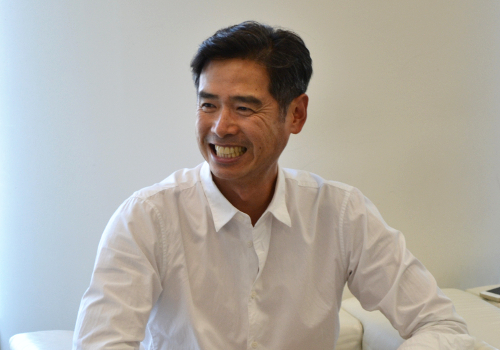
Lee Mingwei
Kataoka Mami (hereafter Kataoka): Another important element of your work is "gift-giving." In addition to meaning a present, the word "gift" in English can refer to a natural talent. In other words, one could say that people with artistic, musical, literary, or any other special talent give their audiences a gift.
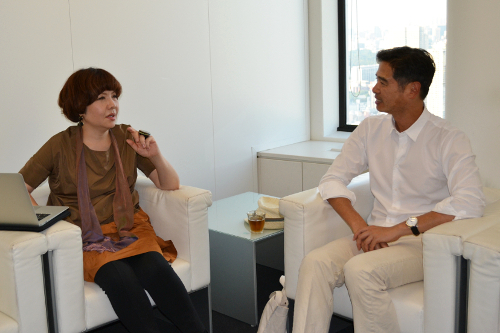
Kataoka Mami (left) and Lee Mingwei (right)
Lee Mingwei (hereafter Lee): Sonic Blossom is a work that I think makes people realize this. It stemmed from experiencing how peaceful and safe my mother - and I - felt after she had surgery by listening to Schubert's Lieder. Fortunately she has recovered completely. In fact, it feels as though she is stronger than before (laughs).
In this project, a singer dressed in a purple robe will approach a visitor in the exhibition space with the question: "May I give you a gift of song?" If the person consents, the singer will sing one of Schubert's Lieder for that person alone.
Originally I thought this project was a gift from the singer to the receiver. But after staging it one or two times, I quickly realized that the receiver is actually a gift-giver to the singer, because they give the singer the chance to realize that their voice has the power to move people to tears. So for them as singers, this project also provides a great gift.
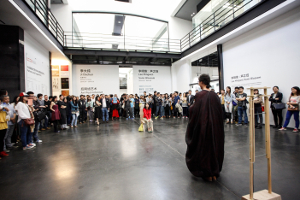
Sonic Blossom
2013
Performance view: Ullens Center for Contemporary Art (UCCA), Beijing, 2014
Photo: Mao Zhenyu
Kataoka: Normally at a concert you see a person singing on stage to an audience of many. So hearing these live songs one-to-one in Sonic Blossom is a very unique experience.
Lee: And also having the singer only about two meters away, you feel the vibration viscerally. Many people shy away because they're afraid they don't understand classical music, but you don't have to understand it. Just use your heart. You can be moved by just the sonic scape and also just the gesture.
Kataoka: The Moving Garden has a similar idea of gift-giving to a stranger. Visitors to the museum see an installation of beautiful fresh flowers, and when they leave the museum they are welcome to take a flower with them, under two conditions: one that they detour from their intended route home, and secondly that they give the flower to a complete stranger they meet along the way.
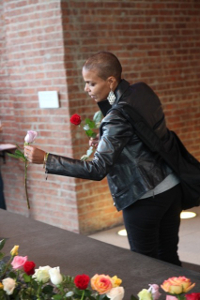
The Moving Garden
2009
Installation view: The 10th Lyon Biennale, France, 2009
Collection: Amy & Leo Shih
Photo: Blaise Adilon
Lee: And by accepting a flower, suddenly you leave the museum wondering, Shall I give it to him ... or her? Will they think I'm crazy? So accepting a flower leads to many internal questions. And hopefully it will lead to something that you weren't expecting, and a transformative experience.
Kataoka: So this flower garden in the gallery space not only moves out of the museum physically, but also, through the act of giving the flower to a stranger, gives rise to psychological expansion as well. The act of giving a stranger a gift changes something inside them.
Lee: In the case of The Letter Writing Project, the emotional chemistry between people changes. This is a project in which visitors to the exhibition can write a letter to a significant other, offering previously unexpressed thoughts or feelings of gratitude or apology. They can then seal their letters (for posting) or leave them unsealed on the shelves where other visitors could read them. Because every night we collect the letters, in the morning there is a fresh slate. So the first few letters become the seeds of the atmosphere for that day. If the first two or three people start writing letters like "Hi. I was here," the letters other visitors write that day tend to be of similarly banal content.
One of the most striking letters I've read so far was a letter of forgiveness that a man wrote to a woman. At the beginning you didn't understand why he was writing to someone he doesn't seem to know, and then at the end you realize the sin he committed vis-à-vis this woman. With that kind of letter, other letters on the same day became very, very emotional and had a sort of raw feeling to them.
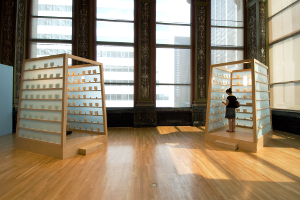
The Letter Writing Project
1998
Installation view: Chicago Cultural Center, 2007
Photo: Anita Kan
Kataoka: The Letter Writing Project also sets a very simple framework, but when you actually read the stories by other people who have participated, it activates your mind, not on the level of theoretical understanding, but richness of feeling.
Lee: I mentioned that the atmosphere of the project changes depending on the kind of letters people write, but it also differs according to time and place. I presented this project in Japan two years ago in a solo show at the Shiseido Gallery. But circumstances have changes greatly over the past two years. So I am very certain that it will be quite different at the Mori Art Museum exhibition.
Original Text (in Japanese-language): Aono Naoko (Editor/writer)
Translation: Miki Pamela
Issue 68 of HILLS LIFE, the latest issue of the area magazine packed with info from street news to trends all to make life at the Hills more fun, features a related conversation between Lee Mingwei and Kataoka Mami. Don't miss it!
Read the PDF edition (in Japanese) here
■Related links
・Dialogue between Lee Mingwei and Kataoka Mami
(1) What is "Participatory Art"?
(2) When "Gift-giving" Becomes Art
(3) Art Enriched by How We Participate
・"Lee Mingwei and His Relations: The Art of Participation: Seeing, Conversing, Gift-giving, Writing, Dining and Getting Connected to the World"
Saturday, September 20, 2014 - Sunday, January 4, 2015
・"MAM Project 022: Jacob Kirkegaard"
Saturday, September 20, 2014 - Sunday, January 4, 2015








